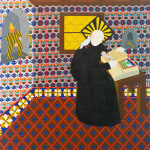Monika Radžiūnaitė Lithuanian, b. 1992
Išblyškęs Linas mintija apie meną / Defluxit Linas cogitat artis // Faded Linas thinks about art / Defluxit Linas cogitat artis, 2020
Aliejus ant drobės / Oil on canvas
150 x 120 x 2.5 cm
Further images
Monika Radžiūnaitė's work, 'Faded Linas thinks about art / Defluxit Linas cogitat artis,' is part of her 'Circumstances' series. Linas, who has not yet reached the 'other side', presents a...
Monika Radžiūnaitė's work, "Faded Linas thinks about art / Defluxit Linas cogitat artis," is part of her "Circumstances" series.
Linas, who has not yet reached the 'other side', presents a daily life narrative that can be viewed as both a portrait of a specific individual and a portrait of someone who has dedicated their life to their work, constantly battling temptations.
On the right, a hunched figure with a white dove on their shoulder writes in a thick book. Behind them, to the left, a gnome is imprisoned behind bars, clutching the bars, clearly yearning for freedom. The small figure's yellow and black striped clothing signifies deceit, sin, and disbelief. Its confinement in a niche with a lock, the key to which lies freely and unprotected next to the writing figure, speaks to the difficult task of resisting one's 'little demons' and continuing to work without giving them attention. It's even harder not to throw the key into a river somewhere, but to keep it always within reach.
The white dove on the figure's shoulder is a reference to the Holy Spirit, whispering truth into the ear, much like Pope Gregory the Great was depicted. With such divine assistance, the writer contemplates, writes, and illustrates the text. The latter cannot be read, but the image reveals its subject – an axe beside the roots of a fruit tree, a direct allusion to the biblical passage: "The axe is already at the root of the trees, and every tree that does not produce good fruit will be cut down and thrown into the fire." Thus, pondering this, this black-robed monk labours for the sake of his good fruits. The ornament borrowed from medieval stained glass, shimmering on the walls, hints at the illuminating quality of stained glass – both literal and metaphorical.
The title of the work unites and resolves the story of the painting by highlighting the power of error. Mistakenly translated into Latin by Google Translate, then re-translated back into Lithuanian, the title reads: "Linas slipped about art." This error creates an opportunity to interpret the work from another perspective, one that doesn't illuminate the character with an idealised light, but rather questions his ability to avoid slipping when contemplating art. This gives rise to a second possibility for interpreting the work – born from an error, yet no less capable of speaking volumes.
Linas, who has not yet reached the 'other side', presents a daily life narrative that can be viewed as both a portrait of a specific individual and a portrait of someone who has dedicated their life to their work, constantly battling temptations.
On the right, a hunched figure with a white dove on their shoulder writes in a thick book. Behind them, to the left, a gnome is imprisoned behind bars, clutching the bars, clearly yearning for freedom. The small figure's yellow and black striped clothing signifies deceit, sin, and disbelief. Its confinement in a niche with a lock, the key to which lies freely and unprotected next to the writing figure, speaks to the difficult task of resisting one's 'little demons' and continuing to work without giving them attention. It's even harder not to throw the key into a river somewhere, but to keep it always within reach.
The white dove on the figure's shoulder is a reference to the Holy Spirit, whispering truth into the ear, much like Pope Gregory the Great was depicted. With such divine assistance, the writer contemplates, writes, and illustrates the text. The latter cannot be read, but the image reveals its subject – an axe beside the roots of a fruit tree, a direct allusion to the biblical passage: "The axe is already at the root of the trees, and every tree that does not produce good fruit will be cut down and thrown into the fire." Thus, pondering this, this black-robed monk labours for the sake of his good fruits. The ornament borrowed from medieval stained glass, shimmering on the walls, hints at the illuminating quality of stained glass – both literal and metaphorical.
The title of the work unites and resolves the story of the painting by highlighting the power of error. Mistakenly translated into Latin by Google Translate, then re-translated back into Lithuanian, the title reads: "Linas slipped about art." This error creates an opportunity to interpret the work from another perspective, one that doesn't illuminate the character with an idealised light, but rather questions his ability to avoid slipping when contemplating art. This gives rise to a second possibility for interpreting the work – born from an error, yet no less capable of speaking volumes.
Exhibitions
2021 - Superfluitates, Pamėnkalnio galerija, VilniusLiterature
BOOKS/CATALOGUES2021 – Superfluitates, interactive catalogue, www.hyperlink.lt, ed.: Linas Bliškevičius, 2021










